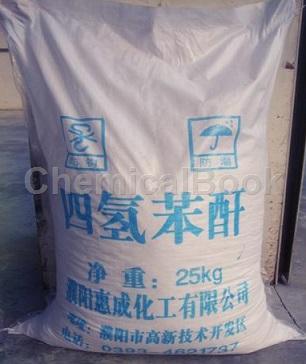Background and overview[1][2]
Tetrahydrophthalic anhydride (THPA), whose molecular formula is C8H8O3, is mainly used as a curing agent for epoxy resins, a modifier for unsaturated polyester resins and alkyd resins, and as a pesticide and pharmaceutical. Important intermediates in synthesis. The synthesis of tetrahydrophthalic anhydride is a typical Diels-Alder condensation reaction, that is, the 1,4 addition reaction of unsaturated maleic anhydride containing ethylenic bonds as a dienophile and diene butadiene containing conjugated double bonds occurs. That is, the diene and the dienophile pass through the cyclic transition state, the breaking of old bonds and the formation of new bonds occur simultaneously, completing the reaction process in one step.
Although the reaction can proceed smoothly at 50℃-120℃ and normal pressure, the reaction time is long, so the reaction is usually performed under pressure to shorten the reaction time. In addition, since the product tetrahydrophthalic anhydride has a high melting point, in order to avoid the precipitation of solid substances and facilitate operation, solvents are usually used. The traditional tetrahydrophthalic anhydride production process is a kettle-type intermittent operation. Its shortcomings are low production efficiency, cumbersome operations, and certain differences in product quality from each kettle.

Apply[3]
Tetrahydrophthalic anhydride, or tetrahydrophthalic anhydride, is an important chemical product with a wide range of uses. For example, it is used as a curing agent for epoxy resins, plasticizers, alkyd resins, Saturated polyester resin is used to produce surfactants, wetting agents, emulsifiers, herbicides, plant growth inhibitors, insecticides, fungicides, insect repellents, fiber treatment agents, lubricant additives, etc.
Tetrahydrophthalic anhydride is one of the downstream products of maleic anhydride. It is a new type of organic acid anhydride epoxy resin curing agent with excellent performance. It is used for alkyd resins and unsaturated resins to improve the adhesion, elasticity, gloss and water resistance of coatings. As a plasticizer, it can improve the cold resistance and heat resistance of PVC and is non-toxic. It is widely used in the electronic and electrical industry and the aerospace field. At the same time, this product is also a raw material for synthetic surfactants and pharmaceutical and pesticide products.
There are also many inconveniences when using solid tetrahydrophthalic anhydride. For example, when used as an epoxy resin curing agent, it needs to be heated and melted first, and then kept warm after feeding to prevent premature solidification. This not only wastes energy, but also causes The operation is complex and the conditions are difficult to control, which affects the stability of product quality.
Research has found that solid tetrahydrophthalic anhydride can be isomerized into a mixture of four isomers. This mixture thermodynamically exhibits the properties of a eutectic, and its freezing point changes according to the ratio of the isomers. Bring to room temperature or lower. Using this liquid tetrahydrophthalic anhydride instead of solid tetrahydrophthalic anhydride in fields such as material synthesis can effectively simplify the production process, reduce production costs, improve product quality, and at the same time benefit the operator’s personal protection. Another significant advantage of liquid tetrahydrophthalic anhydride is that it can be purified by simple distillation, which makes it possible for us to produce high-purity products from low-purity raw materials.
Preparation[2]
The existing production technology of liquid tetrahydrophthalic anhydride is to use solid tetrahydrophthalic anhydride, Δ4-tetrahydrophthalic anhydride, as raw material, in the presence of a catalyst, continue to stir and heat to isomerize it, and then filter or distill it to obtain the product. The catalyst can be cheap phosphorus pentoxide, phosphoric acid, concentrated sulfuric acid, etc. Therefore, its production cost mainly depends on the cost of the raw material solid tetrahydrophthalic anhydride. However, the 1,3-butadiene currently needed to produce solid tetrahydrophthalic anhydride is extracted from mixed C4, a by-product of petroleum cracking. The extraction process is quite complicated and the price is relatively high.
If mixed C4 is used instead of 1,3-butadiene to react with maleic anhydride, the production cost will undoubtedly be greatly reduced. However, in addition to about 40-50% of 1,3-butadiene, mixed C4 also contains Contains a variety of complex components such as n-butene, isobutylene, n-butane, isobutane, etc., which makes side reactions more likely to occur, or even causes the reaction to get out of control and completely generate polymers. Therefore, when using mixed C4 and maleic anhydride to react, it is necessary to maintain a lower reaction temperature, and the existing methods of lowering the reaction temperature are by adding a large amount of solvents, such as benzene, xylene, etc., which is very important for protecting the environment. , It is very disadvantageous to reduce costs.
Change 100g of maleic anhydride is heated until melted, 0.3g of hydroquinone (polymerization inhibitor) and 0.5g of phosphorus pentoxide (isomerization catalyst) are added, and the mixed C4 is poured into the maleic anhydride melt at a speed of 1.0g/min. , keep the reaction temperature at 100-105°C; use gas chromatography to track and analyze the composition changes of the reaction mixture. When the maleic anhydride content drops to zero, increase the reaction temperature to 160°C and continue the reaction for 2 hours; distill under reduced pressure and collect 120-140 °C/5mmHg fraction, 133g of colorless transparent liquid was obtained, with a purity of 99.2%, a yield of 85%, and a freezing point of <15 °C.
Main reference materials
[1] Fan Chun. (2009). Synthesis and isomerization of tetrahydrophthalic anhydride. (Doctoral dissertation, Beijing University of Chemical Technology).
[2] Qian Ming, & Zhang Haifeng. (1998). Research on the synthesis of 1,2,5,6-tetrahydrophthalic anhydride. Shandong Chemical Industry (3), 15-16.
[3] Feng Shihong, Ding Bingwei, Zhang Zhenbin, Wu Hongmei, & Guo Yu. (2018). Pd-ni/δ-al2o3 is used in the selective catalytic hydrogenation of tetrahydrophthalic anhydride to hexahydrophthalic anhydride. Chemistry World, 59( 7).


